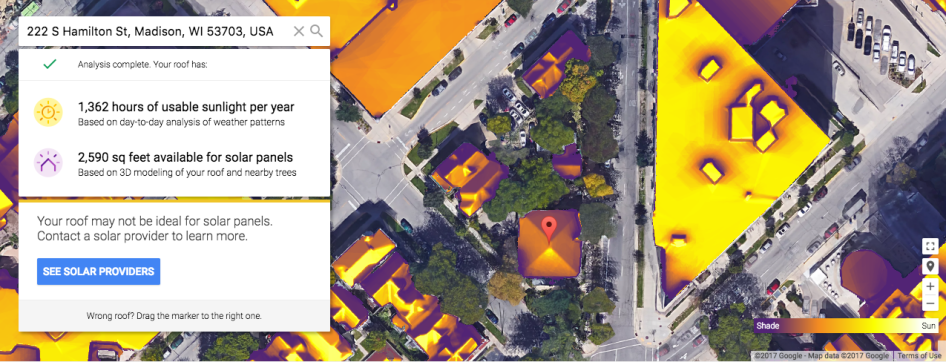Is my home ideal for solar?
Homes that are ideal for rooftop solar typically:
1. Are not shaded by trees, buildings or other obstacles,
2. Have south-, east-, or west-facing rooftops, and
3. Are structurally sound and in relatively new condition.
Households participating in the group buy will be offered free site assessments from our solar installation partners. When you sign up, we’ll take a look at your home on satellite imagery and ask you a few questions before scheduling your assessment.
If you’re serious about going solar, you can get a jump start by checking out your home on Google’s Project Sunroof. Continue reading below for other key considerations.

How do I use Project Sunroof?
1. Go to Google Project Sunroof
2. Enter your home address in the search bar
3. Click “Check My Roof”
4. Your home will then appear colored with a red pin over it just as the image below shows
What should I be looking for?
Color: The color of your roof models how much sunlight you receive. This is a useful indicator of whether solar may be a good idea for your property.
All yellow: Your roof has little to no shading and solar looks like an excellent option for your home!
Yellow/light orange: Your roof has some shading, but solar can still be a great investment for you.
Orange/red/purple: Your roof has a significant amount of shading, which means solar may not make sense for your home.
What determines the color of my roof?
Orientation of your roof: You will notice that bright yellow roofs are either flat or south-facing. This is because south-facing roofs receive the most sunlight compared to other orientations. However, if your home has a west facing roof, solar still can be a great investment if you switch to Time-of-Use Metering.
Shading from surrounding buildings or trees: If your roof is south-facing, but it’s still colored darker, it’s likely that it’s being shaded by surrounding buildings or trees. Keep in mind that if you have had trees removed or made other changes to your property that are not reflected in the satellite imagery, the model will not be accurate.
What else should I consider?
Orientation and shading are important, but there are other factors too. Consider,
The size of your roof: A typical residential solar installation will require at least 300 square feet of roof space. However, this varies depending on the size of the solar system being installed.
The condition of your roof: Your roof should be in good condition before installing solar panels. If you anticipate re-roofing your home in the next 5-10 years, it may make sense to wait on installing solar.
The energy efficiency of your home: Investing in efficient appliances and lighting, for example, can have a big impact on your electric bill. And when you use less electricity, even a small solar array can meet your needs.
Caution!
This is only a rough estimate and you should not rely on these numbers. We think the color coding is very helpful. But we have found that the true numbers for (1) hours of sunlight and (2) the square feet available for solar can vary significantly from the estimates provided by the model. Again, keep in mind that if you have had trees removed or made other changes to your property that are not reflected in the satellite imagery, the model will not be accurate.
Get a free solar site assessment from a trusted professional. This is the best way to estimate your potential solar production. Through the MadiSUN program, our installation partner will come to your home to take accurate measurements and evaluate your property to provide you a free, customized quote and proposal.